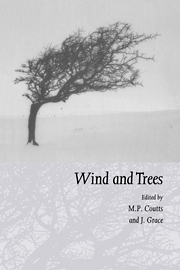Book contents
- Frontmatter
- Contents
- Preface
- List of contributors
- Part I Airflow over topography and in forests
- 1 Turbulent airflow in forests on flat and hilly terrain
- 2 The interactions of wind and tree movement in forest canopies
- 3 Edge effects on diffusivity in the roughness layer over a forest
- 4 A wind tunnel study of turbulent airflow in forest clearcuts
- 5 Testing of a linear airflow model for flow over complex terrain and subject to stable, structured stratification
- 6 Predicting windspeeds for forest areas in complex terrain
- Part II Mechanics of trees under wind loading
- Part III Tree physiological responses
- Part IV Impacts of wind on forests and ecology
- Part V Risk assessment and management response
- Index
6 - Predicting windspeeds for forest areas in complex terrain
Published online by Cambridge University Press: 27 October 2009
- Frontmatter
- Contents
- Preface
- List of contributors
- Part I Airflow over topography and in forests
- 1 Turbulent airflow in forests on flat and hilly terrain
- 2 The interactions of wind and tree movement in forest canopies
- 3 Edge effects on diffusivity in the roughness layer over a forest
- 4 A wind tunnel study of turbulent airflow in forest clearcuts
- 5 Testing of a linear airflow model for flow over complex terrain and subject to stable, structured stratification
- 6 Predicting windspeeds for forest areas in complex terrain
- Part II Mechanics of trees under wind loading
- Part III Tree physiological responses
- Part IV Impacts of wind on forests and ecology
- Part V Risk assessment and management response
- Index
Summary
Abstract
The determination of the wind regime in a potential or existing forest area is an important aspect of any site assessment. Wind affects the growth rate of the trees and determines the occurrence of windthrow in the later years of the development of a forest. Consequently the prediction of tree growth, and the forecast of the financial viability of any forest project, are dependent upon an accurate assessment of the windspeed. Many forestry locations have sparse windspeed records due to difficulties of siting equipment in remote areas. In Britain, methods of windspeed assessment for such purposes have included the use of tatter flags and, more recently, numerical and statistical modelling techniques. An attempt is made here to relate windspeed to the topographic and geographic characteristics of the site in order to avoid the necessity for long-term on-site wind measurements. The variables related to windspeed are altitude, which has a recognised relationship with windspeed, topex (a measure of the exposure of a site), roughness length (related to the height of the surface elements), United Kingdom Ordnance Survey grid position, and distance to the coast. Initially, each geographic variable is related individually to annual mean windspeed at a set of 21 sites, taken from both the Forestry Commission and United Kingdom Meteorological Office networks. Subsequently, the variables are related in multiple regression equations to the annual mean windspeeds of 1989 and these equations are then used to predict the windspeeds in 1990. A test of the method has been made on an independent site not used in the previous stages. The results are encouraging.
- Type
- Chapter
- Information
- Wind and Trees , pp. 113 - 130Publisher: Cambridge University PressPrint publication year: 1995
- 18
- Cited by

